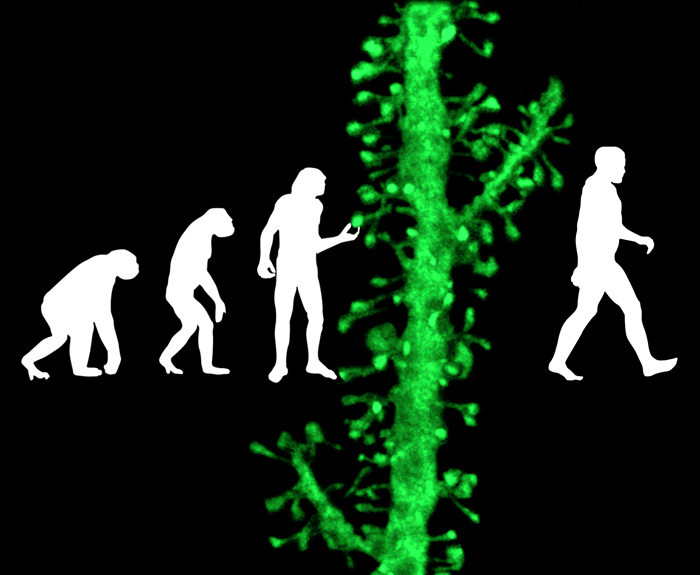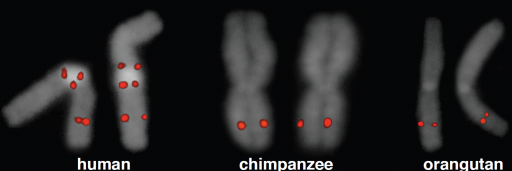How a gene copy helped our brains become ‘human’
May 8, 2012

As humans evolved, an extra copy of a brain-development gene allowed neurons to migrate farther and develop more connections via their dendritic spines ("leaves" in green) image (credit: Polleux lab, Scripps Research Institute)
Could an extra copy of a brain-development gene that appeared in our ancestors’ genomes about 2.4 million years ago have allowed maturing neurons to migrate farther and develop more connections?
That’s a theory that Scripps Research scientists have now found evidence for. But surprisingly, the added copy of the SRGAP2 gene does not augment the function of the original gene, which makes pyramidal neurons sprout connections.
Instead, the extra gene copy interferes with that original function. So how could that make humans more intelligent? Because it effectively gives neurons more time to wire themselves into a bigger brain.
“This is a major example of a single genomic innovation that contributed to human evolution,” said Franck Polleux, a professor at The Scripps Research Institute.
“The finding that a duplicated gene can interact with the original copy also suggests a new way to think about how evolution occurs and might give us clues to human-specific developmental disorders such as autism and schizophrenia.”
The emergence of the extra gene copy (named SRGAP2C) occurred roughly 2.4 million years ago — corresponding approximately to the time when the (extinct) Australopithecus and the Homo sapiens lineages separated.

What makes humans smarter: three distinct copies of SRGAP2 gene on metaphase human chromosome 1, compared to a single copy in chimpanzee and orangutan (credit: Polleux lab, Scripps Research Institute/Cell)
History of the discovery
Polleux specializes in the study of human brain development, and, several years ago, his lab began researching the function of the newly-discovered SRGAP2. He and his colleagues found that in mice, the gene’s protein product plays a key role during brain development: It deforms the membranes of young neurons outward, forcing the growth of root-like appendages called filopodia.
As young neurons sprout these filopodia, they migrate more slowly through the expanding brain. Eventually, they reach their final position, where they form connections. Most excitatory connections made on pyramidal neurons in the cortex are formed on spines, which are microscopic protrusions from the dendrite playing a critical role in integrating synaptic signals from other neurons.
SRGAP2 was among the few genes (approximately 30) that had been duplicated in the human genome less than six million years ago after separation from other apes. “These evolutionarily recent gene duplications are so nearly identical to the original genes that they aren’t detectable by traditional genome sequencing methods,” said Polleux. “Only in the last five years have scientists developed methods to reliably map these hominid-specific duplications.”
Hardly any of the new-found human-specific gene duplications had been characterized functionally. SRGAP2 was an exception; its prominent role in brain maturation made its recent duplication a possible factor in human evolution. So Polleux and his colleagues set out to determine whether SRGAP2’s duplication had affected its function in the human brain.
It was a challenging task, since SRGAP2’s duplicates are nearly indistinguishable from the original and are found only in human cells, so they can’t be studied in lab mice. As a first step, Polleux and his colleagues performed a detailed search of human cells’ chromosome 1, where SRGAP2 resides, and confirmed the presence of two nearby copies (SRGAP2B and SRGAP2C), that are more than 99 percent identical with the original copy (re-named SRGAP2A) in humans.
How to create intelligent mice
After developing sensitive probes to distinguish these genes and their protein products from those of the original SRGAP2A, the researchers looked for their expression in human cell and brain-tissue cultures. The scientists determined that only one, SRGAP2C, was biologically active and expressed at high levels. The SRGAP2C protein turned out to be a truncated version of the original SRGAP2 protein. It lacks SRGAP2’s ability to promote neuronal spine maturation, but it is far from inert: it latches onto the original, full-length SRGAP2 protein and inhibits its normal functions.
Polleux’s team expressed human SRGAP2C in vivo in mouse cortical neurons throughout development and found that the effects on brain development were essentially the same as those they observed when the scientists blocked the expression of the original SRGAP2 gene. The affected neurons—pyramidal neurons, the major neurons of the cortex—migrated faster and took much longer to sprout their full complement of dendritic spines. This delayed spine maturation had an unexpected effect: pyramidal neurons ultimately formed many more spines when they finally matured—just like human pyramidal neurons.
Curiously, these dendritic spines also had the longer necks seen on human pyramidal neurons. “Other researchers have argued that as spine density increased during human evolution, longer spine necks might be needed to provide greater electrical and biochemical isolation and thus keep the neurons from becoming hyper-excitable and prone to triggering seizures,” Polleux said. “SRGAP2C seems to be important for that key evolutionary change.”
Interestingly, Polleux and colleagues found that mice with deleted SRGAP2 are prone to seizures. “A genetic study published by another laboratory in Japan last November found similar results in children born with rare SRGAP2 gene mutations,” noted Polleux.
The emergence of Homo sapiens
Oddly enough, SRGAP2B, the relatively inactive duplication of SRGAP2, was the one that occurred first—roughly 3.4 million years ago, according to Eichler’s genomic dating techniques. The active SRGAP2C appeared even more recently through duplication of SRGAP2B, with about 1 million years separating the two duplications. SRGAP2C emergence occurred roughly 2.4 million years ago—corresponding approximately to the time when the Australopithecus and the Homo lineages separated.
Taken together, the results from the Eichler and Polleux labs suggest that SRGAP2C duplication in the Homo lineage might have provided a selective advantage in part by slowing the rate of spine maturation, allowing the emergence of more connections between cortical neurons.
About 30 other protein-coding genes were duplicated as the early hominid genome evolved towards the modern human one, and Polleux’s lab is now working with Eichler’s to characterize the ancestral copies of these genes and their human-specific duplications. “There was probably a co-evolution of these genomic changes that together made the human brain unique,” Polleux said.
Future treatments for autism and schizophrenia?
The study of human-specific gene duplications could lead to a better understanding of human developmental disorders. Autism and schizophrenia, for example, are known to feature abnormal neuronal connectivity and affect synaptic development, but have been difficult to model accurately in mouse models. Gene duplications such as SRGAP2C, which normally don’t occur in mice, could provide important missing pieces of these puzzles.
“We plan to augment existing mouse models by adding some of these human-specific gene duplications,” said Polleux. This approach, called “humanization,” has been used successfully in other fields such as immunology for the past two decades to model disease mechanisms, but has so far not been applied to neuroscience. The Polleux and Eichler groups also plan to team up to conduct human genetic studies to determine if mutations or other copy-number variations in SRGAP2C or other human-specific duplications lead to neurodevelopmental disorders.
“This human-specific portion of the genome has not been looked at so far since it is poorly assembled, but we suspect that it might contain the answers to some long-standing mysteries about human diseases,” Polleux said.
Funding for the research came from the National Institute for Health (NINDS) and ADI-Novartis funds.
Ref.: Cécile Charrier et al., Inhibition of SRGAP2 Function by Its Human-Specific Paralogs Induces Neoteny during Spine Maturation, Cell, 2012, DOI: 10.1016/j.cell.2012.03.034
Ref.: Megan Y. Dennis et al., Evolution of Human-Specific Neural SRGAP2 Genes by Incomplete Segmental Duplication, Cell, 2012, DOI: 10.1016/j.cell.2012.03.033